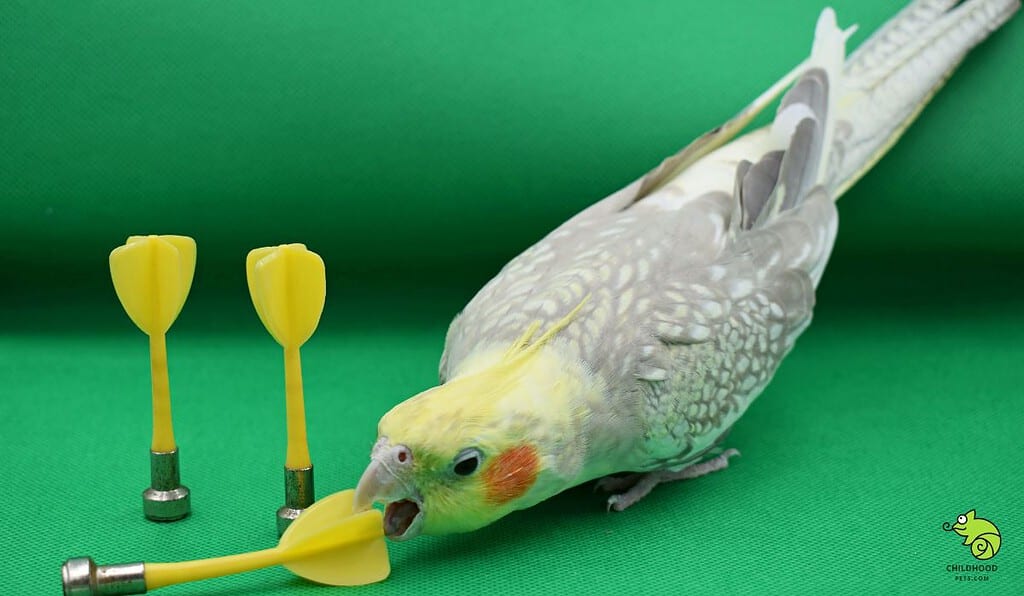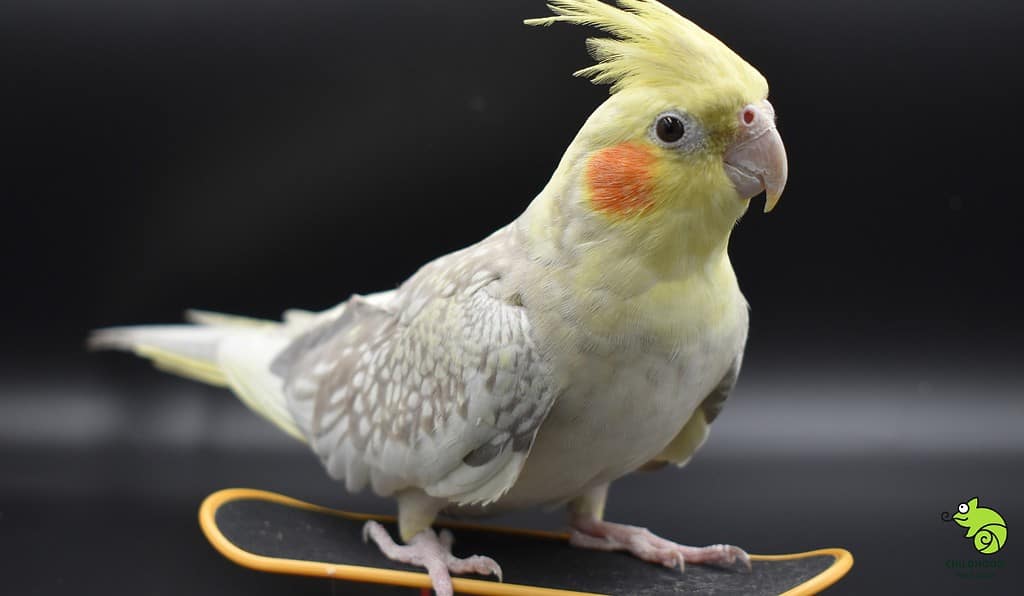
Cockatiels, with their vibrant crests and captivating personalities, have always been a favorite among bird enthusiasts. But have you ever wondered how these feathered wonders perceive the world around them? Their vision, intricate and unique, offers them a perspective of the world that’s vastly different from ours.
As a general rule, cockatiels possess an impressive 180-degree field of vision, allowing them to spot potential threats even from behind. Their eyes, larger in proportion to their head size, not only provide them with sharper eyesight but also enable them to see a broader spectrum of colors, including ultraviolet light.
Lets Explore the intricacies of their sight, from understanding night frights to the importance of providing optimal vision conditions. Let’s embark on this enlightening journey together!
How Do Cockatiels See the World?
Cockatiels perceive the world through a unique lens. Their eyes are designed to capture a broader spectrum of colors, including ultraviolet light, revealing hidden markings and patterns. With an impressive 180-degree field of vision, they can view their surroundings almost panoramically. This wide vision aids them in spotting potential threats and navigating their environment. Additionally, their larger eyes relative to their head size grant them sharper eyesight, allowing them to discern minute details. In essence, the world through a cockatiel’s eyes is vibrant, detailed, and expansive.
Can Cockatiels See in the Dark?
Cockatiels possess a heightened sensitivity in their eyes, allowing them to see better in low-light conditions. While they don’t have complete night vision like some nocturnal animals, their eyes are designed to capture even the faintest light, aiding them in dim environments. However, they cannot see in complete darkness. This sensitivity is a double-edged sword, as it can sometimes lead to episodes of “night frights” when unexpected shadows or movements startle them during the night. It’s essential to provide them with a soft light source during their resting hours to prevent such occurrences.
Do Cockatiels see colours?
Cockatiels have a remarkable ability to perceive colors, much more vividly than we might imagine. They can distinctly differentiate between primary colors like red, blue, and green. This color perception plays a pivotal role in their daily activities. For instance, discerning specific colors aids them in locating food, especially fruits and seeds. Moreover, vibrant plumage colors can be indicators of a potential mate’s health and vitality, making color recognition crucial during mating rituals. Additionally, the ability to spot certain colors can be a lifesaver, helping them identify and evade predators. To further understand the vastness of their color spectrum, consider the table below which compares the color spectrum visible to cockatiels with that of humans.
How Far Can a Cockatiel See?
Cockatiels, with their keen eyesight, have the ability to see great distances, especially when in flight. Their vision is adapted to spot distant landmarks, potential food sources, and even predators from afar. While it’s challenging to pinpoint an exact distance they can see, their large eyes relative to their head size provide them with a broader and clearer field of view. This enhanced vision ensures they can navigate their surroundings effectively, whether in their natural habitat or a domestic setting. It’s this remarkable visual acuity that aids them in their daily activities and survival instincts.
Cockatiel Eye Anatomy and Physiology
Cockatiels, like us, have a fascinating ocular structure that allows them to perceive the world around them. When I first began my journey as a veterinarian, I was particularly intrigued by the anatomy of bird eyes, especially cockatiels. Their eyes, though similar to ours in some aspects, have unique characteristics that set them apart.
Cockatiels have eyes with a cornea, iris, pupil, lens, and retina. Cockatiels possess much larger eyes relative to their head size. This not only gives them sharper eyesight but also enables them to see a broader spectrum of their surroundings.
Cockatiel Eyes Features:
| Feature | Cockatiel |
| Cornea | Protects the eye and refracts light |
| Iris | Controls the amount of light entering the eye |
| Pupil | Allows light to enter the eye |
| Lens | Focuses light onto the retina |
| Retina | Processes light and sends signals to the brain |
| Eye Size | Larger relative to head size |
Field of View: A Cockatiel’s Eye Perspective

One of the most remarkable features of a cockatiel’s vision is its expansive field of view. Imagine being able to see almost a full circle around you without even turning your head. Cockatiels boast an impressive 180-degree field of vision, which is particularly advantageous in the wild. This wide field of view means they can spot potential threats, even if they’re approaching from behind.
Advantages of a Wide Field of View for Birds:
- Predator Detection: With such a broad vision, cockatiels can easily spot predators, ensuring they have ample time to escape.
- Food Location: A wide field of view aids in efficiently locating food sources in their natural habitat.
- Social Interaction: Birds can keep an eye on their flock, ensuring they remain close and connected.
- Navigational Aid: When flying, a broad vision helps in navigating through dense forests and avoiding obstacles.
- Mating: Spotting potential mates becomes easier, ensuring the continuation of their species.
Depth Perception and Ultraviolet Vision
Depth perception is another fascinating aspect of cockatiel vision. Thanks to their binocular vision, cockatiels can view an object with both eyes simultaneously. This ability is vital as it helps them judge distances, especially when they’re flying or navigating through obstacles.
Moreover, cockatiels have a unique capability that we humans lack: they can see ultraviolet (UV) light. This ability opens up a whole new world for them, revealing patterns, markings, and signals that remain hidden from our eyes.
Ways Ultraviolet Vision Benefits Cockatiels:
- Enhanced Food Detection: UV light can make certain food sources stand out, making foraging easier.
- Mating Advantages: Some birds have UV-reflective feathers, which can be attractive during mating rituals.
- Navigation: UV light can help in navigation, especially during migrations.
- Social Interactions: UV markings can play a role in bird-to-bird communications.
- Safety: Detecting UV-reflective trails left by predators can alert them to potential dangers.
- Territorial Boundaries: UV markings can be used to establish and recognize territories.
Understanding Night Frights in Cockatiel’s
Cockatiels have excellent night vision, which is a testament to their adaptability and survival instincts. However, this doesn’t make them immune to the phenomenon known as “night frights.”
Night frights are sudden episodes of panic that cockatiels can experience during the night. These episodes can be distressing for both the bird and the owner. As someone who has witnessed this firsthand, I can tell you that understanding the triggers can help in preventing these episodes.
Common Causes of Night Frights and Their Solutions
| Causes | Solutions |
| Unexpected Loud Noises | Maintain a quiet environment; consider using white noise machines. |
| Shadows or Moving Objects | Use blackout curtains; ensure the cage is placed away from busy areas. |
| Presence of Other Pets | Keep other pets away from the cockatiel’s cage during the night. |
| Changes in Environment | Introduce changes gradually; keep familiar toys or perches in the cage. |
| Underlying Health Issues | Regular vet check-ups; monitor for any unusual behavior or symptoms. |
Factors Affecting Cockatiel Vision
Cockatiels’ vision can be affected by various factors. Age-related vision decline is natural, and as cockatiels age, they might not see as sharply as they once did. Health conditions, like cataracts, can also impact their vision. Furthermore, the lighting in a cockatiel’s cage plays a pivotal role. Optimal lighting conditions can enhance their vision, while poor lighting can lead to issues like “night frights.” The cage environment and its surroundings also play a significant role in a cockatiel’s visual experience.
Tips for Maintaining Optimal Vision Conditions for Cockatiels:
- Ensure the cage is well-lit during the day.
- Avoid placing the cage in direct sunlight.
- Use bird-safe full-spectrum lights.
- Regularly clean the cage and toys to ensure clarity.
- Provide toys and perches at varying heights to stimulate their visual senses.
Importance of Providing Optimal Vision Conditions to Cockatiel’s
The environment we provide for our feathered friends plays a crucial role in their overall well-being. From the toys to the perches, every element in a cockatiel’s cage contributes to their visual experience.
Essential Items for a Cockatiel’s Cage to Enhance Their Visual Experience:
- Full-Spectrum Lights: Mimics natural sunlight, promoting better vision and overall health.
- Varied Perches: Different textures and sizes stimulate their feet and provide varied viewpoints.
- Colorful Toys: Engages their vision and keeps them mentally stimulated.
- Mirrors: Some cockatiels enjoy interacting with their reflection, but use with caution as it can also lead to aggressive behavior in some birds.
- Natural Elements: Incorporating natural branches or leaves can provide a more authentic environment.
Conclusion
Understanding the intricacies of cockatiel vision has been a journey of discovery for me. From their unique ability to see ultraviolet light to their challenges with night frights, there’s so much to learn and appreciate about these feathered wonders. The more we understand our cockatiels, the better we can cater to their needs.
I hope this article sheds light on the captivating world of cockatiel vision. If you found this informative, I encourage you to share your thoughts in the comments and share this article with fellow bird enthusiasts.
Frequently Asked Questions
Do cockatiels sleep in complete darkness?
No, cockatiels prefer low light conditions but not complete darkness, which can cause night frights.
Do cockatiels like to be covered at night?
Many cockatiels prefer being covered at night, as it offers a sense of security and reduces disturbances.
Do cockatiels have good eyesight?
Yes, cockatiels have excellent eyesight, featuring an impressive 180-degree field of vision and the ability to see in ultraviolet light.
How well can cockatiels see in the dark?
In the dark, cockatiels rely on their heightened night vision, which allows them to perceive shapes and objects to a certain extent.
